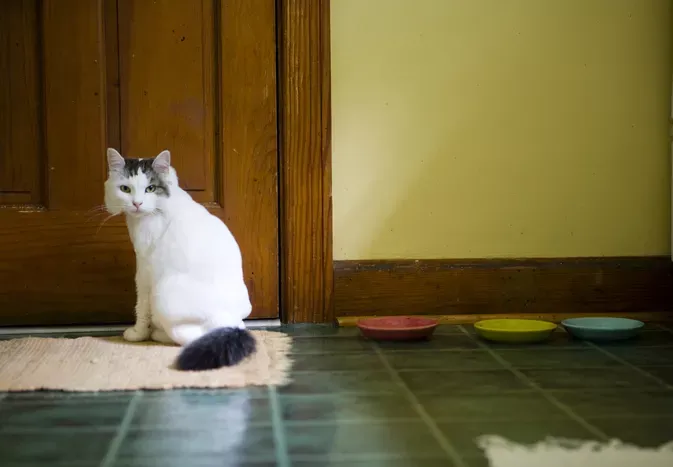How to Stop Cats From Pooping on Rugs
Updated on 04/26/24

How to Stop Cats From Pooping on Rugs: A Comprehensive Guide
Introduction:
As much as we adore our feline friends, their occasional accidents on rugs can be a frustrating and unsanitary problem. If your cat has taken a liking to pooping on your prized carpets, don't despair. With patience, consistency, and a few clever strategies, you can effectively discourage this undesirable behavior and restore harmony to your home.
1. Identify the Underlying Causes:
Before implementing any solutions, it's crucial to understand why your cat is pooping on rugs in the first place. Some common causes include:
* Medical issues: Underlying health conditions, such as digestive disorders or urinary tract infections, can lead to inappropriate elimination. Consult your veterinarian to rule out any medical concerns.
* Stress or anxiety: Cats can become stressed due to changes in their environment, new pets or people in the household, or perceived threats. This stress can manifest as inappropriate elimination.
* Litter box issues: Ensure the litter box is clean, spacious enough, and placed in a quiet, private location away from high-traffic areas. Also, consider the type of litter used; some cats may prefer different textures or scents.
* Territorial marking: Unneutered or unspayed cats may use pooping to mark their territory if they feel threatened or insecure. Neutering or spaying can help reduce this behavior.
2. Clean Up Accidents Thoroughly:
When you discover a poop accident on the rug, it's essential to clean it up promptly and thoroughly to eliminate any lingering odors that could attract your cat back to the spot.
* Remove the solid waste: Use a paper towel or plastic bag to gently remove the poop. Avoid using bleach, as this can be harmful to cats.
* Enzyme cleaner: Enzymatic cleaners are designed to break down the organic matter in pet urine and feces, neutralizing the odor and discouraging future accidents. Follow the instructions carefully and allow the cleaner to soak into the rug for the recommended time.
* Steam cleaning: Steam cleaning can effectively remove lingering odors and kill bacteria, but it's important to test the cleaner on a small, inconspicuous area of the rug first to ensure it doesn't damage the fabric.
3. Make the Rugs Less Appealing:
Create an environment that discourages your cat from pooping on rugs by making them less appealing:
* Place a scratching post nearby: Provide a designated spot for your cat to scratch and mark their territory, reducing the likelihood they'll choose rugs instead.
* Use double-sided tape: Cats dislike the sticky feel of double-sided tape on their paws. Placing strips of tape on the areas where your cat tends to poop can effectively deter them.
* Cover rugs with plastic sheeting: Create a temporary barrier by covering rugs with clear plastic sheeting during times when your cat is more likely to have accidents. The smooth, slippery surface will make the rug less appealing as a pooping spot.
4. Train Your Cat to Use the Litter Box:
Re-establish the litter box as the designated elimination spot by following these techniques:
* Positive reinforcement: Reward your cat with treats, praise, or toys whenever they use the litter box appropriately.
* Supervise after accidents: When your cat has an accident on the rug, gently pick them up and place them in the litter box. This will help them associate the litter box with elimination.
* Feliway diffuser: Feliway diffusers release synthetic pheromones that mimic the facial pheromones of cats, creating a calming and reassuring environment. This can help reduce stress and anxiety, which may contribute to inappropriate elimination.
5. Manage Stress and Anxiety:
Address any potential sources of stress or anxiety in your cat's environment:
* Provide hiding places: Cats feel safe and secure in enclosed spaces. Provide them with multiple hiding places, such as cat caves or cardboard boxes, where they can retreat when feeling overwhelmed.
* Feliway spray: Feliway spray can be used on areas or objects that tend to trigger stress in your cat, creating a calming effect.
* Calming music or white noise: Create a relaxing atmosphere in your home by playing calming music or white noise, which can help reduce stress levels.
6. Be Patient and Consistent:
Changing your cat's behavior takes time and consistency. Be patient and don't get discouraged if you don't see results immediately. Continue implementing these strategies diligently, and eventually, your cat will learn to associate rugs with a negative experience and seek out the litter box instead.
Conclusion:
By understanding the underlying causes, employing effective cleaning techniques, making rugs less appealing, training your cat, managing stress and anxiety, and being patient and consistent, you can successfully stop your cat from pooping on rugs. Remember, each cat is unique, so tailor your approach to their individual needs and preferences. With patience and determination, you can restore harmony to your home and enjoy a clean and poop-free living space.
Explore More Pets

Cat Behavior Problems
How to Stop Aggression in Kittens

Long-Haired Cat Breeds
Siberian Cat: Breed Profile, Characteristics, & Care

Cat Behavior Problems
How to Stop Kittens From Scratching and Biting

Long-Haired Cat Breeds
Turkish Angora: Cat Breed Profile, Characteristics & Care

Basic Training
How to Socialize Your Kitten

Short-Haired Cat Breeds
Cute Pictures & Facts About Calico Cats & Kittens

Litter Box Training
Training Your Kitten to Use the Litter Box

Long-Haired Cat Breeds
10 Fun Facts About White Cats